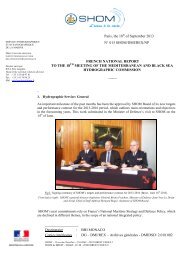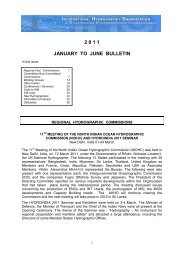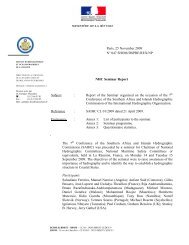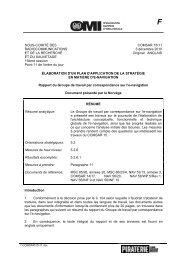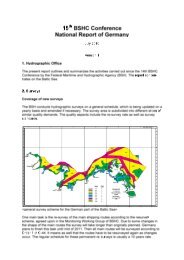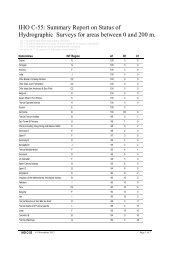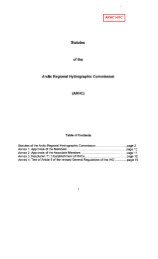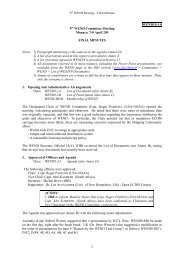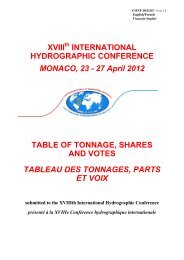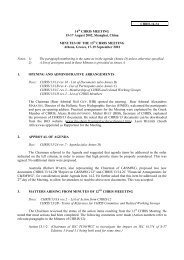The Relevance of Hydrography to UNCLOS
The Relevance of Hydrography to UNCLOS
The Relevance of Hydrography to UNCLOS
You also want an ePaper? Increase the reach of your titles
YUMPU automatically turns print PDFs into web optimized ePapers that Google loves.
<strong>The</strong> <strong>Relevance</strong> <strong>of</strong> <strong>Hydrography</strong> <strong>to</strong> <strong>UNCLOS</strong>; an Indonesian Perspective<br />
By:<br />
Pr<strong>of</strong>. Dr. Hasjim Djalal, MA*<br />
As I understand it, the theme <strong>of</strong> this 6 th ABLOS Conference 2010 is “Contentious Issues in<br />
<strong>UNCLOS</strong>- surely not?”. As I understand it, there are a lot <strong>of</strong> issues in <strong>UNCLOS</strong> that could be<br />
contentious on which ABLOS could play a role in clarifying them, and look in<strong>to</strong> the<br />
relevance <strong>of</strong> hydrography <strong>to</strong> <strong>UNCLOS</strong>.<br />
1. Under the Law <strong>of</strong> the Sea there are usually different meaning between hydrography,<br />
hydrographic survey, and marine scientific research. <strong>Hydrography</strong> generally means<br />
knowledge with regard <strong>to</strong> the bodies <strong>of</strong> water, generally relating <strong>to</strong>: (1) depth <strong>of</strong><br />
water, configuration and the nature <strong>of</strong> the seabed; (2) directions and force <strong>of</strong><br />
current; (3) heights and times <strong>of</strong> tides and water stages; (4) location <strong>of</strong> <strong>to</strong>pographic<br />
features and fix objects for survey and navigation purposes.<br />
2. Hydrographic survey means a survey <strong>of</strong> the bodies <strong>of</strong> water directed for specific<br />
purposes, such as; (1) for the purposes <strong>of</strong> safety <strong>of</strong> navigation, (2) for construction <strong>of</strong><br />
artificial islands, structures and installation at sea, and even for (3) the purposes <strong>of</strong><br />
making and constructing port and post installation.<br />
3. On the other hand, Marine Scientific Research (MSR) means activities undertaken in<br />
the marine environment <strong>to</strong> enhance scientific knowledge regarding the nature and<br />
natural processes <strong>of</strong> the seas and oceans, the seabed and subsoil there<strong>of</strong>.<br />
4. <strong>UNCLOS</strong> 1982 contains some provisions regarding the hydrographic survey and<br />
marine scientific research. For instance Article 21 (1) stipulates that coastal states<br />
“may adopt laws and regulations, in conformity with the provisions <strong>of</strong> this Convention<br />
and other rules <strong>of</strong> International Law, relating <strong>to</strong> innocent passage through the terri<strong>to</strong>rial<br />
sea, in respect <strong>of</strong> all or any <strong>of</strong> the following: (a) the safety <strong>of</strong> navigation and the<br />
regulation <strong>of</strong> marine traffic……… (g) marine scientific research and hydrographic<br />
surveys.”<br />
1
5. In addition, Article 40 <strong>of</strong> <strong>UNCLOS</strong> stated that during transit passage through straits<br />
used for international navigation, “foreign ships, including marine scientific research<br />
and hydrographic survey ships may not carry out any research or survey activities<br />
without the prior authorization <strong>of</strong> the states bordering straits”.<br />
6. It should also be noted that the prohibition <strong>to</strong> the conduct marine scientific research and<br />
hydrographic survey without prior authorization <strong>of</strong> the coastal state is also applicable in<br />
the archipelagic waters in accordance with Article 54 <strong>of</strong> the <strong>UNCLOS</strong> 1982.<br />
7. <strong>The</strong> problem <strong>of</strong> marine scientific research and hydrographic survey in the EEZ may<br />
create some problems. On the one hand, Article 56 (1) indicated that in the EEZ, the<br />
coastal state has sovereign rights for the purpose <strong>of</strong> exploring and exploiting,<br />
conserving and managing the natural resources, whether living or non living <strong>of</strong> the<br />
EEZ and with regard <strong>to</strong> other activities for the economic exploitation and exploration <strong>of</strong><br />
the zone, such as the production <strong>of</strong> energy from the waters and wind. In Addition, Article<br />
56 also stated that the coastal states has jurisdiction with regard <strong>to</strong>, among others<br />
marine scientific research.<br />
8. On the other hand, Article 58 <strong>of</strong> <strong>UNCLOS</strong> indicated that the freedoms <strong>of</strong> the sea as<br />
indicated in Article 87 also applied <strong>to</strong> the EEZ as far as navigation and over flights<br />
(and others) are concerned.<br />
9. <strong>The</strong>refore there has been some confusion with regard <strong>to</strong> the regime <strong>of</strong> hydrographic<br />
survey in the EEZ whether it would be under the freedoms <strong>of</strong> the sea, or under the<br />
jurisdiction <strong>of</strong> the coastal states. One argument would say that hydrographic survey is not<br />
directly related <strong>to</strong> exploring, conserving and managing the natural resources <strong>of</strong> the EEZ,<br />
and therefore should be free for all states.<br />
10. On the other hand, many coastal states would argue that they have jurisdiction with<br />
regard <strong>to</strong> regulating and authorizing marine scientific research in the EEZ. Although<br />
hydrographic survey was not clearly stated within the jurisdiction <strong>of</strong> the coastal state as<br />
stipulated in Article 56(1) (d), the coastal states considered that hydrographic survey<br />
have direct relations <strong>to</strong> their security.<br />
2
11. In view <strong>of</strong> this , a certain group <strong>of</strong> experts on the Law <strong>of</strong> the Sea, the so called Group <strong>of</strong><br />
21 consisting <strong>of</strong> Law <strong>of</strong> the Sea experts from Japan, Australia, Indonesia, Malaysia,<br />
the Philippines, China , Republic <strong>of</strong> Korea, India, Russia, the United States,<br />
International Tribunal for the Law <strong>of</strong> the Sea, and others have carried out several<br />
meetings, such as in Bali (June 2002), Tokyo (February 2003), Honolulu (2 December<br />
2003), Shanghai (Oc<strong>to</strong>ber 2004), and Tokyo (September 2005) under the sponsorship <strong>of</strong><br />
the Ocean Policy Research Foundation (OPRF) <strong>of</strong> Japan, and co-sponsored by the Center<br />
for Southeast Asian studies In Jakarta, <strong>The</strong> East West Center in Honolulu, and the School<br />
<strong>of</strong> International and Public Affair at Shanghai Jiao-Tong University, have formulated<br />
certain Guidelines for the navigation and overflight in the EEZ.<br />
12. As far as hydrographic surveying in the EEZ is concerned, the Guidelines stated as<br />
follows:<br />
a. Hydrographic surveying should only be conducted in the EEZ <strong>of</strong> another state<br />
with the consent <strong>of</strong> the coastal state. This does not apply <strong>to</strong> the collection <strong>of</strong><br />
navigational data by a ship required for safe navigation during the ship’s<br />
passage through an EEZ.<br />
b. Coastal State consent for hydrographic surveying should normally be<br />
granted unless the surveys fall within one <strong>of</strong> the consent categories in Article<br />
246(5) <strong>of</strong> the 1982 <strong>UNCLOS</strong>, such as having direct significance for the<br />
exploration and exploitation <strong>of</strong> natural resources, whether living or non-living.<br />
c. <strong>The</strong> Guidelines in Articles VIII and IX also apply <strong>to</strong> aircraft, au<strong>to</strong>nomous<br />
underwater vehicles (AUVs), remotely operated vehicles (ROVs) and<br />
other remotely operated devices <strong>of</strong> a state conducting research or collecting<br />
data in EEZ.<br />
13. <strong>Hydrography</strong> is also very closely related <strong>to</strong> <strong>UNCLOS</strong> 1982 and is very crucial in<br />
implementing its provisions. For instance, it is very crucial in determining the baselines<br />
for measuring terri<strong>to</strong>rial sea, contiguous zones, EEZ, and continental shelf. <strong>The</strong>re are<br />
many kinds <strong>of</strong> baselines. According <strong>to</strong> Article 5 <strong>of</strong> <strong>UNCLOS</strong> 1982, the normal baselines<br />
for measuring the breadth <strong>of</strong> the terri<strong>to</strong>rial sea is the low water line along the coasts as<br />
marked on large scale charts <strong>of</strong>ficially recognized by the coastal states. Hydrographic<br />
knowledge is crucial in determining the location <strong>of</strong> the “low water line” along the coast.<br />
3
14. Equally, hydrography is very important <strong>to</strong> determine the seaward low water line <strong>of</strong> the<br />
reefs as shown by the appropriate symbol on chart <strong>of</strong>ficially recognized by the coastal<br />
states, because those low water lines could be used as baselines for measuring the<br />
breadth <strong>of</strong> the terri<strong>to</strong>rial sea as stipulated in Article 6.<br />
15. <strong>The</strong> role <strong>of</strong> hydrography is also significance in determining straight baselines where the<br />
coastline is deeply indented or cut in<strong>to</strong>, or if there is a fringe <strong>of</strong> islands along the coast<br />
in its immediate vicinity as stated in Article 7 (1). Also <strong>to</strong> select appropriate points<br />
along the furthest seaward extent <strong>of</strong> the low water line <strong>of</strong> a delta, as stipulated in<br />
Article 7 (2).<br />
16. Similar hydrographic roles would also be important in determining straight baselines<br />
across the mouth <strong>of</strong> the river between points on the low water line <strong>of</strong> its banks as<br />
stipulated in Article 9 or across a bay as indicated in Article 10.<br />
17. Another significant role <strong>of</strong> hydrography would be in determining a low tide elevation,<br />
primarily because the location <strong>of</strong> that low tide elevation could influence the extent <strong>of</strong><br />
straight baselines for measuring the terri<strong>to</strong>rial sea.<br />
18. All these indicate the significant role <strong>of</strong> hydrography in determining and measuring the<br />
location <strong>of</strong> the various features at sea, such as the reefs, the coastline deeply indented<br />
and cut in<strong>to</strong>, the fringe <strong>of</strong> islands along the coast, the mouth <strong>of</strong> rivers, bays, ports,<br />
roadsteads, and low tide elevations.<br />
19. <strong>The</strong> role <strong>of</strong> hydrography is also important in the delimitation process <strong>of</strong> the terri<strong>to</strong>rial<br />
seas between states with opposite or adjacent coast. In such a case, according <strong>to</strong><br />
Article 15, failing agreement <strong>to</strong> the contrary, neither <strong>of</strong> the two states can extend its<br />
terri<strong>to</strong>rial sea “beyond the median line every points <strong>of</strong> which is equidistant from the<br />
nearest points on the baselines from which the breadth <strong>of</strong> the terri<strong>to</strong>rial seas <strong>of</strong> each <strong>of</strong><br />
the two states is measured”. Only hydrographic research that could determine those<br />
median line for the delimitation between the two states and <strong>to</strong> show them on charts or<br />
provide a list <strong>of</strong> geographical coordinates <strong>of</strong> points, specifying the geodetic datum as<br />
stipulated in Article 16.<br />
4
20. <strong>The</strong> hydrographic activities are also essential <strong>to</strong> determine “the outermost points <strong>of</strong> the<br />
outermost islands and drying reefs <strong>of</strong> archipelago” as stated in Article 47 (1) which<br />
are essential as basis for drawing “straight archipelagic baselines”. In this context, it<br />
should be noted that there is no specific length <strong>of</strong> “straight baselines” for normal<br />
terri<strong>to</strong>rial sea, but there is a specific rule for the length <strong>of</strong> “straight archipelagic baselines”<br />
as stipulated in Article 47 (2) <strong>of</strong> <strong>UNCLOS</strong>, namely 100 miles with the exception that not<br />
more than 3 % <strong>of</strong> the number <strong>of</strong> the baselines could be up <strong>to</strong> 125 miles.<br />
21. Needless <strong>to</strong> say that hydrographic knowledge is important <strong>to</strong> determine the various<br />
base points, the connecting baselines, the 12 miles extent <strong>of</strong> the terri<strong>to</strong>rial seas from<br />
the baselines, the 24 miles extent <strong>of</strong> the contiguous zone from the terri<strong>to</strong>rial sea<br />
baselines and the 200 miles EEZ boundaries, also from the terri<strong>to</strong>rial sea baselines. In<br />
addition, hydrographic knowledge is also crucial in determining the outer edge <strong>of</strong> the<br />
continental margin beyond the 200 mile limits, particularly the determination <strong>of</strong> the<br />
existence <strong>of</strong> submarine ridges, plateau , rises, caps, banks, and spurs which are part <strong>of</strong><br />
the continental margin. Hydrographic survey and knowledge is extremely significant in<br />
determining 2500 meters isobaths as the possible basis <strong>to</strong> start counting possible limit<br />
<strong>of</strong> 100 miles for measuring the outer limit <strong>of</strong> the continental margin (Article 76 (5) <strong>of</strong><br />
<strong>UNCLOS</strong>) as the limit <strong>of</strong> the continental shelf beyond the distance <strong>of</strong> 200 miles from the<br />
baselines as stipulated in Article 76 <strong>of</strong> <strong>UNCLOS</strong>. <strong>The</strong> determination <strong>of</strong> the thickness<br />
<strong>of</strong> sedimentary rocks from the foot <strong>of</strong> the continental slope also requires scientific<br />
contribution from hydrography (as well as from geology and geomorphology). In fact,<br />
hydrography, <strong>to</strong>gether with other disciplines, also play significant roles in determining<br />
the foot <strong>of</strong> the continental slope from which the continental margin could be measured,<br />
namely not more than 60 miles from the foot <strong>of</strong> the slope as stated in Article 76 (4 (a) (ii))<br />
22. Equally, the role <strong>of</strong> hydrography is also important <strong>to</strong> define continental margin beyond<br />
200 miles from the baselines, particularly <strong>to</strong> determine “the thickness <strong>of</strong> sedimentary<br />
rocks and <strong>to</strong> measure their distances from the foot <strong>of</strong> the continental slope, <strong>to</strong> determine<br />
the point <strong>of</strong> 60 miles from the foot <strong>of</strong> continental slope, as well as the points <strong>of</strong> 100 miles<br />
from the 2500 meter isobath, and the maximum <strong>of</strong> 350 miles from the baselines as the<br />
limit the continental margin for limiting the outer limit <strong>of</strong> the continental shelves as stated<br />
in Article 76 (5) <strong>of</strong> <strong>UNCLOS</strong>.<br />
5
23. <strong>The</strong> problems would be more difficult, however, with regard <strong>to</strong> the delimitation between<br />
states <strong>of</strong> EEZ and continental shelf. If for the delimitation <strong>of</strong> terri<strong>to</strong>rial sea the rule <strong>of</strong><br />
“median line” seems <strong>to</strong> be clear, the dominant rule for the delimitation <strong>of</strong> EEZ and<br />
continental shelf, however, is “<strong>to</strong> achieve an equitable solution” (Article 74 (1) and<br />
Article 83 (1)). <strong>The</strong>re is no clear guidelines as <strong>to</strong> what is “an equitable solution”, except<br />
that it should be achieved “by agreement” between the parties.<br />
24. For the purpose <strong>of</strong> safety <strong>of</strong> navigation, hydrographic survey is crucially important <strong>to</strong><br />
identify and map out those features and characteristic <strong>of</strong> each body <strong>of</strong> waters. It is<br />
extremely significant in the area <strong>of</strong> traffic density, such as in the straits <strong>of</strong> Malacca and<br />
Singapore and in other straits <strong>of</strong> Indonesia which are heavily navigated, either by<br />
national or foreign shipping entities. <strong>The</strong> hydrography survey is also very significant for<br />
underwater navigation, particularly in the deeper waters <strong>of</strong> Indonesia in the eastern<br />
provinces.<br />
25. Hydrographic survey is also significant with regard <strong>to</strong> the possible exploration and<br />
exploitation <strong>of</strong> the seabed area and its subsoil. Such activities would depend a great<br />
deal on the development <strong>of</strong> technology, and more countries are developing technologies<br />
for exploration and exploitation <strong>of</strong> ocean resources deeper and deeper from the surface <strong>of</strong><br />
the sea. Hydrographic knowledge with regard <strong>to</strong> bot<strong>to</strong>m <strong>to</strong>pography as well as bot<strong>to</strong>m<br />
currents and other oceanographic and geological knowledge are very significant and<br />
influential in these endeavors.<br />
26. In these contexts, it is also important <strong>to</strong> note the provisions <strong>of</strong> Article 121 <strong>of</strong> <strong>UNCLOS</strong><br />
with regard <strong>to</strong> the differentiation between “islands” and “rocks”. An island is defined<br />
as “a naturally formed area <strong>of</strong> land, surrounded by water, which is above water at high<br />
tide”. An island can have terri<strong>to</strong>rial sea, the contiguous zone, EEZ, as well as continental<br />
shelve/continental margin. On the other hand, Article 121 (3) apparently differentiates<br />
between rocks which can “sustain human habitation or economic life <strong>of</strong> their own”<br />
and those rocks which can not. Rocks which can not sustain human habitation or<br />
economic life <strong>of</strong> their own, can not be considered “islands”, and therefore they can not<br />
have economic zone or continental shelve. It is not clear whether there is a rock that can<br />
sustain human habitation or economic life <strong>of</strong> their own. Artificial islands “or” rocks<br />
6
which have been modified by artificial human intervention, such as by land reclamation<br />
or technique, it seems <strong>to</strong> me, would be difficult <strong>to</strong> classify as “naturally formed area <strong>of</strong><br />
land” and therefore, like installations and structures, can not be used <strong>to</strong> claim terri<strong>to</strong>rial<br />
sea, contiguous zone, EEZ, or continental shelf. Artificial islands do not have the status<br />
<strong>of</strong> island. <strong>The</strong>refore they can not have terri<strong>to</strong>rial sea <strong>of</strong> their own.<br />
27. <strong>The</strong> problems <strong>of</strong> rock in the middle <strong>of</strong> the seas and oceans are now major issues,<br />
particularly in the Pacific Ocean and the South China Sea which have the tendency <strong>to</strong><br />
develop in<strong>to</strong> conflicts between states. I wonder whether ABLOS could find some<br />
solutions <strong>to</strong> those issues including the issues <strong>of</strong> land reclamation in determining baselines.<br />
<strong>Hydrography</strong> and other technical scientific disciplines could play significant role in<br />
differentiating between rocks and island and in what way a rock can sustain human<br />
habitation or economic life <strong>of</strong> their own so that it can have the terri<strong>to</strong>rial sea, EEZ, and<br />
continental shelve, thus could become “an island”.<br />
28. In my views, in order <strong>to</strong> be able <strong>to</strong> “sustain human habitation or economic life <strong>of</strong> their<br />
own, the rocks must have sufficient fresh water, suitable vegetation <strong>to</strong> produce food,<br />
sufficient materials <strong>to</strong> construct shelters and accommodation, and <strong>to</strong> support the survival<br />
and proliferation <strong>of</strong> certain limited community <strong>of</strong> people. <strong>The</strong> situation may also be<br />
different with regard <strong>to</strong> rocks which could be regarded as a part <strong>of</strong> the coastal area<br />
which could be regarded as the outermost points <strong>of</strong> the outermost islands which could be<br />
used as base points <strong>to</strong> start measuring the baseline <strong>of</strong> a coastal state.<br />
29. Finally, I wonder whether hydrography could also helped <strong>to</strong> solve the problems <strong>of</strong><br />
“special circumstances” or the problems <strong>of</strong> “his<strong>to</strong>ric title” as stated in Article 15 <strong>of</strong><br />
<strong>UNCLOS</strong> that would enable the delimitation <strong>of</strong> terri<strong>to</strong>rial sea between state with opposite<br />
or adjacent coasts <strong>to</strong> deviate from the general principles <strong>of</strong> median line. Do the “special<br />
circumstances” relate <strong>to</strong> the location <strong>of</strong> a feature or the size <strong>of</strong> the feature or perhaps<br />
<strong>to</strong> other situations. Similarly what would constitute “his<strong>to</strong>ric title”. <strong>The</strong> uncertainty with<br />
regard <strong>to</strong> the meaning <strong>of</strong> this criteria has created a lot <strong>of</strong> confusions and potential<br />
conflicts in the South China Sea, mainly because some claimants in the area are claiming<br />
their rights on the basis <strong>of</strong> the undefined “his<strong>to</strong>ric title” and in some cases controversial<br />
“his<strong>to</strong>ric title”<br />
7
30. To conclude, hydrographic survey is very relevance <strong>to</strong> the implementation <strong>of</strong><br />
<strong>UNCLOS</strong>. It is therefore essential <strong>to</strong> increase knowledge and understanding <strong>of</strong><br />
hydrography for ocean and maritime management, not only for the purpose <strong>of</strong> navigation<br />
but also for the purposes <strong>of</strong> exploration and management <strong>of</strong> the marine resources and<br />
their environment. It is however important for hydrography <strong>to</strong> coordinate and<br />
synergize their activities with other relevant disciplines such as oceanography,<br />
geology, metrology and others in order <strong>to</strong> maximize its benefits and contribution.<br />
* Pr<strong>of</strong>. Dr. Hasjim Djalal, MA, graduated from the University <strong>of</strong> Virginia, Charlottesville,<br />
VA, in 1953 (MA) and 1961 (PhD). He was a career diplomat, former Ambassador <strong>to</strong> the UN<br />
in New York (1981-1983), Canada (1983-1985), Germany (1990-1993), and Ambassador At-<br />
Large for the Law <strong>of</strong> <strong>The</strong> Sea and Maritime Issues (1994-2000). He participated fully in the<br />
preparation, negotiation, and implementation <strong>of</strong> the Law <strong>of</strong> the Sea Convention 1982 from<br />
1969 up <strong>to</strong> the present. He was president <strong>of</strong> the International Seabed Authority in Jamaica<br />
(1995-1996) and is now chairman <strong>of</strong> its Finance Committee. Domestically, Pr<strong>of</strong>. Djalal is<br />
now a member <strong>of</strong> Indonesian Maritime Council, adviser <strong>to</strong> the Minister <strong>of</strong> Ocean Affairs and<br />
Fisheries, <strong>to</strong> the Minister <strong>of</strong> Transportation, <strong>to</strong> the Minister <strong>of</strong> Defence, <strong>to</strong> the Naval Chief <strong>of</strong><br />
Staff, <strong>to</strong> the Ministry <strong>of</strong> Foreign Affairs and lecturers at various educational institutions in<br />
Indonesia. He writes extensively in Indonesia and abroad.<br />
This paper is <strong>to</strong> be presented at ABLOS International Symposium, Monaco, 25-27 Oc<strong>to</strong>ber<br />
2010.<br />
8



